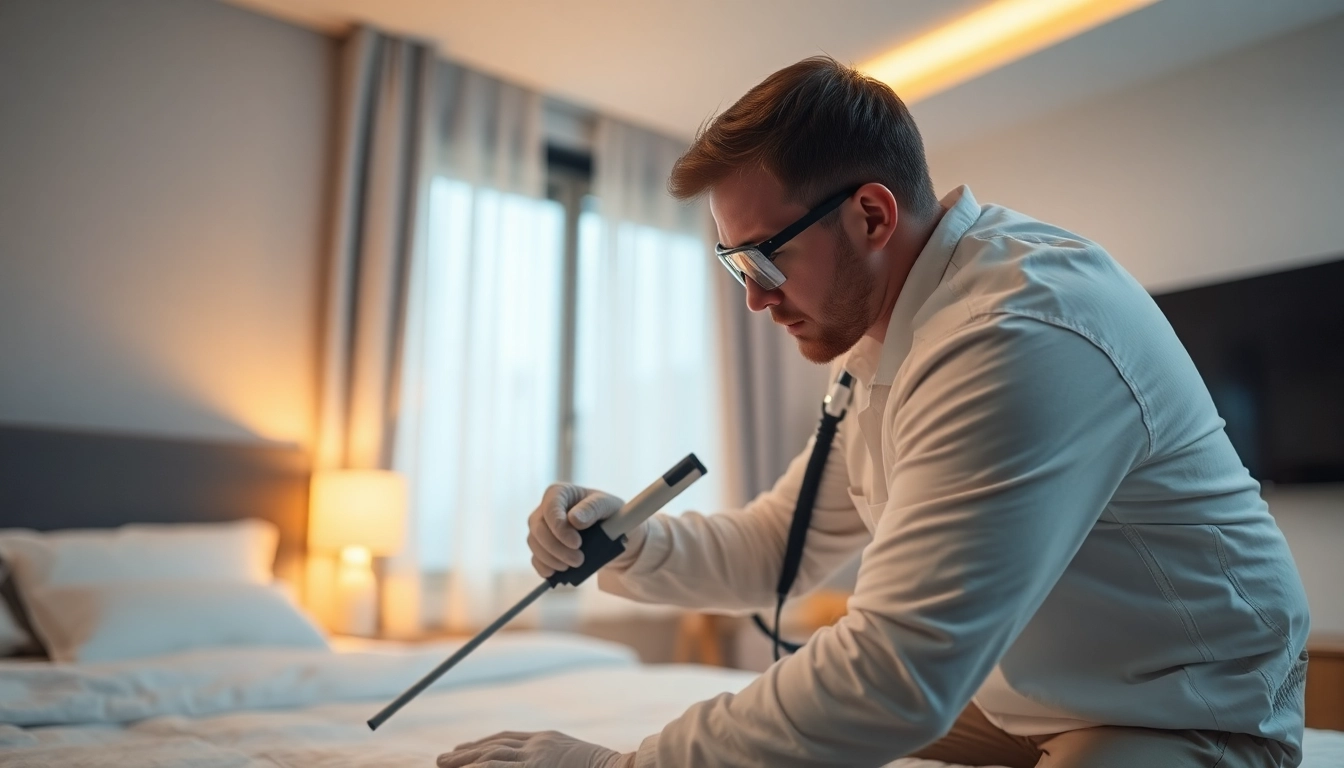Understanding Bed Bugs and Their Habitats
What Are Bed Bugs?
Bed bugs are small, wingless insects belonging to the Cimex lectularius species. These pests are notorious for their ability to thrive in human dwellings, feeding primarily on blood. Adult bed bugs are about 5-7 mm long and have a flat, oval shape, which allows them to hide discreetly in various crevices. They are often reddish-brown in color, and their distinctive oval shape makes them easily identifiable. Despite their name, bed bugs can be found in various locations beyond just beds, making them a widespread issue in residential and commercial spaces alike.
Common Hiding Places for Bed Bugs
Bed bugs are masters of hiding, preferring to stay out of sight when not feeding. Common hiding spots include:
- Mattresses and box springs
- Bed frames and headboards
- Couches and upholstered furniture
- Carpets and rugs, particularly along edges and corners
- Electrical outlets and appliances
- Cracks in walls and furniture
- Behind loose wallpaper or picture frames
Understanding these hiding places is crucial for effective Bed Bug Removal, as it helps target infestations at the source.
Signs of Infestation
Identifying a bed bug infestation early is critical for effective eradication. Some signs to look out for include:
- Small, reddish-brown spots on bedding or furniture, which are bed bug excrement
- Skin molts, as bed bugs shed their exoskeletons
- Live bugs, often hiding in crevices or seams of furniture
- Unexplained bites on the skin, typically in clusters or lines
If you notice any of these signs, it’s essential to act quickly to control the infestation before it spreads.
DIY Bed Bug Removal Techniques
Initial Steps for Bed Bug Removal
Before considering professional help, many homeowners opt to take initial steps at home. Here are some effective methods for DIY bed bug removal:
- Declutter: Remove unnecessary items from the infested rooms to reduce hiding spots for bed bugs.
- Launder fabrics: Wash bedding, clothing, and curtains in hot water (at least 120°F or 49°C) and dry them on the highest heat setting.
- Vacuum: Thoroughly vacuum carpets, floors, furniture, and even behind baseboards. Use a vacuum with a HEPA filter to trap bed bugs.
- Steam treatment: Use a steam cleaner to treat areas where bed bugs may hide. The heat from steam (above 130°F or 54°C) effectively kills them.
Effective Home Remedies
Several home remedies have been touted for bed bug removal, though their effectiveness can vary. Here are some common remedies:
- Diatomaceous earth: This powdery substance is made from fossilized algae and can dehydrate bed bugs. Sprinkle it in areas where they are likely to hide, but ensure it remains dry.
- Rubbing alcohol: Spraying rubbing alcohol can kill bed bugs on contact. However, it evaporates quickly and may not provide long-lasting results.
- Essential oils: Some people use oils like tea tree, lavender, or peppermint, which may repel bed bugs. However, they are typically not a standalone solution.
While these remedies can assist in controlling small infestations, they may not be sufficient against larger populations.
When to Seek Professional Help
If you find that your DIY attempts have not completely eradicated the issue, or if the infestation appears extensive, it’s advisable to seek professional help. Experts can identify all infested areas and apply more powerful treatments effectively and safely.
Professional Bed Bug Removal Services
How Exterminators Approach Bed Bug Removal
Professional exterminators use an integrated pest management (IPM) approach to bed bug removal, which may include:
- Inspection: They start with a thorough inspection to locate hiding spots and assess the extent of the infestation.
- Treatment options: Using chemical pesticides, heat treatments, or a combination of methods tailored to the unique situation.
- Monitoring: Post-treatment, exterminators often set up monitoring devices to ensure the problem has been effectively resolved.
Professionals bring expertise and tools that enhance the likelihood of complete elimination.
Cost Estimates and What to Expect
The cost of professional bed bug removal can vary significantly based on the severity of the infestation, location, and treatment methods used. On average, you can expect to pay between $300 to $1,500 for comprehensive treatment. It’s crucial to understand what your service includes, such as follow-up visits or warranty options against reinfestation.
Choosing the Right Pest Control Company
When selecting a pest control service, consider the following:
- Experience and certifications: Look for companies with costumer referrals and expertise in bed bug eradication.
- Integrated Pest Management strategies: Check if they employ IPM techniques instead of relying solely on chemical treatments.
- Customer reviews: Read testimonials and reviews to gauge satisfaction levels.
Choosing the right pest control company can significantly affect the success of your bed bug removal efforts.
Preventing Future Bed Bug Infestations
Best Practices for Preventive Measures
Preventing bed bugs from returning involves a few best practices:
- Seal cracks and crevices in walls and furniture to eliminate potential hiding spots.
- Regularly inspect second-hand furniture before bringing it into your home.
- Use bed bug-proof mattress encasements to protect against re-infestation.
Monitoring and Maintenance Tips
Continuing to monitor for signs of bed bugs after treatment is vital. Here are some tips:
- Regularly check mattress seams and bed frames for signs of bed bugs.
- Consider installing bed bug interceptors under the legs of beds and furniture to trap any bugs attempting to climb up.
- Keep a pest control log to track inspections and any signs of bed bugs.
Traveling Safely to Avoid Bed Bugs
When traveling, taking precautions can help avoid bringing bed bugs home:
- Inspect your hotel room for signs of bed bugs when you arrive.
- Keep luggage elevated on luggage racks or shelves rather than on beds or floors.
- Launder clothing promptly upon returning home, keeping it separate from unwashed items.
Common Myths and Misconceptions About Bed Bugs
Debunking Bed Bug Myths
Several misconceptions surround bed bugs that can hinder effective management:
- Myth: Bed bugs only live in dirty homes. Reality: Bed bugs can thrive in any environment, clean or dirty, as long as there are hosts (humans) to feed on.
- Myth: Bed bugs are only found in beds. Reality: They can hide in many locations, including furniture, carpets, and even electrical outlets.
- Myth: Mattress sprays can eliminate bed bugs completely. Reality: While sprays can help kill some adults, they often do not touch eggs and cannot reach bugs in hiding.
Understanding the Risks of Infestations
Bed bugs pose various risks to not only physical well-being but also mental health. The stress from dealing with an infestation can lead to anxiety and insomnia, greatly affecting the quality of life. Prompt identification and effective management of infestations are essential to mitigate these risks.
Fact vs. Fiction: What You Should Know
In summary, it’s crucial to educate yourself about the true nature of bed bugs rather than relying on myths. The more you know about their habits, hiding spots, and how they spread, the better equipped you will be to prevent and handle infestations effectively.



